





Although we earn income from the advertising which we carry, Oremus relies on donations from readers to cover its production costs.
The Companions of Oremus was established to recognise those who give generously to support us. Open exclusively to individuals, Companions’ names are published in the magazine each month (see page 7). All members are invited to one or more social events during the year and Mass is offered for their intentions from time to time.
If you would like to support us by joining the Companions, please write to Oremus, Cathedral Clergy House, 42 Francis Street, London SW1P 1QW or email oremuscomps@rcdow.org.uk with your contact details, including postcode. Members are asked to give a minimum of £100 annually. Please mention how you would like your name to appear in our membership list and if you are eligible to Gift Aid your donation. Postal subscriptions to Oremus may be purchased by completing and sending to the office the coupon printed in the magazine. Subscriptions to receive Oremus either by email (free) or as hard copy by post (p & p payable) can also be entered by visiting https://westminstercathedral.org.uk/the-cathedral-community/about-oremus/ and completing the form there.
Thank you for your support.
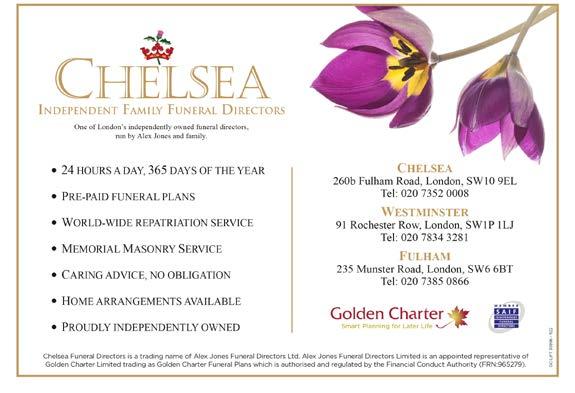
Cathedral Clergy House
42 Francis Street
London SW1P 1QW
T 020 7798 9055

E oremus@westminstercathedral.org.uk
W www.westminstercathedral.org.uk
Oremus, the magazine of Westminster Cathedral, reflects the life of the Cathedral and the lives of those who make it a place of faith in central London. If you think that you would like to contribute an article or an item of news, please contact the Editor.
Patron
The Cardinal Archbishop of Westminster
Chairman
Fr Sławomir Witon´
Editor
Lorcán Keller
Oremus Team
Tony Banks – Distribution
Marie Carne – Content Compilation
Ellen Gomes – Archives
Zoe Goodway – Marketing & Finance
Paul Moynihan – Proofreading
Manel Silva – Subscriptions
Design and Art Direction
Julian Game
Registered Charity Number 233699 ISSN 1366-7203
Opinions expressed by contributors do not necessarily represent the views of the Editor or the Oremus Team. Neither are they the official views of Westminster Cathedral. The Editor reserves the right to edit all contributions. Publication of advertisements does not imply any form of recommendation or endorsement. Unless otherwise stated, photographs are published under a creative commons or similar licence. Every effort is made to credit all images. No part of this publication may be reproduced without permission.

Born Jorge Mario Bergoglio on 17 December 1936 in Buenos Aires, Argentina, he was ordained for the Society of Jesus on 13 December 1969. On 27 June 1992, Bergoglio was ordained Titular Bishop of Auca, Auxiliary of Buenos Aires, and installed as Archbishop of Buenos Aires in 1998. On 21 February 2001, he was made Cardinal Priest of the Church of St Robert Bellarmine, by Pope St John Paul II. Following Pope Benedict XVI’s abdication, Bergoglio was elected as Pope on 13 March 2013, taking the name Francis. Following treatment for bilateral pneumonia in February, Pope Francis returned home to the Casa Santa Marta, where he died days later on Easter Monday, 21 April 2025. May he rest in peace.
© Mazur/catholicnews.org.uk
Cathedral Life
Homily: Pope Francis’ Requiem by Cardinal Vincent Nichols
A Vatican Adventure! by Fr Brian O’Mahony, Sub-Dean
Cathedral History in Pictures: The Mayor of Westminster, 1960 by Paul Tobin

The Welsh Martyrs by Louise Sage
Choir Tour of USA by Mr Robert O’Brien
Sherrington
&

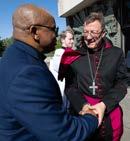

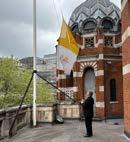



On Easter Monday morning, I was not entirely full of the Resurrection. Indeed, bleary eyed after the rigours of Holy Week and livestreaming duties, I awoke determined to get this edition of Oremus finished, days after we should have gone to print.
What I soon discovered was that Pope Francis had died earlier that morning, aged 88. May he rest in eternal peace. At 9.45am in Rome, fellowDrimnagh-man and Drimnagh Castle alumnus, Cardinal Kevin Farrell, Camerlengo of the Holy Roman Church, announced:
‘Dearest brothers and sisters, with deep sorrow I must announce the death of our Holy Father Francis. At 7.35 this morning, the Bishop of Rome, Francis, returned to the house of the Father. His entire life was dedicated to the service of the Lord and of his Church. He taught us to live the values of the Gospel with fidelity, courage, and universal love, especially in favour of the poorest and most marginalised. With immense gratitude for his example as a true disciple of the Lord Jesus, we commend the soul of Pope Francis to the infinite merciful love of the One and Triune God.’
Having rushed to the Cathedral, the Piazza was swarming with journalists and film crew. The sleepy bank holiday was then spent liaising with the media, who were keen to get access to the press conference at 3pm in the Throne Room of Archbishop’s House, and filming rights for the 5.30pm Requiem Mass. In a few short hours, that Solemn Requiem, celebrated by Cardinal Nichols, was organised and under way. The Print Room was closed and so Head Steward Trevor Koschalka spent the day sweating over photocopiers that were in no humour to cooperate, printing last-minute orders of service. Despite his valiant efforts, so many people arrived that no amount of printing would have sufficed.
As I write this, we are still squarely in the nine days of mourning, but many people have already come to pay their respects and to sign the books of condolence.
Looking forward, the Conclave will likely begin at some point in the week beginning Sunday 4 May, followed that evening by a Mass of the Holy Spirit, here in Westminster Cathedral. Thursday 8 May is VE Day, the 80th anniversary of Victory in Europe following the end of the Second World War. Indeed, this was intended to be the focus of the May edition. Later this month, we will also bid farewell to Bishop John Sherrington, as he takes up his appointment as Archbishop of Liverpool. A Mass of farewell will take place here on 15 May.
Happy Easter!
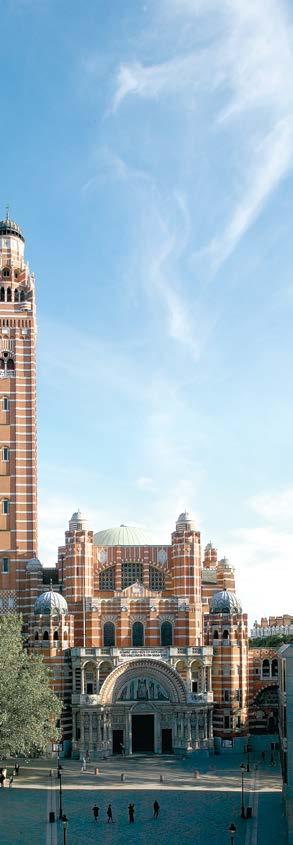
Westminster Cathedral
Cathedral Clergy House
42 Francis Street
London SW1P 1QW
Telephone 020 7798 9055
Email chreception@rcdow.org.uk
www.westminstercathedral.org.uk
Cathedral Chaplains
Fr Sławomir Witoń, Dean
Fr Brian O’Mahony, Sub-Dean
Fr Patrick van der Vorst, Precentor
Fr John Scott, Registrar
Fr Vincent Mbu’i SVD
Fr Paul Zhao SVD
Fr Hugh MacKenzie
Fr Javier Ruiz-Ortiz (priest in residence)
Also in residence
Franciscan Sisters of Our Lady of Victories: Sr Jesuina, Sr Angelina and Sr Fatima
Music Department
Simon Johnson, Master of Music
Peter Stevens Obl. OSB, Assistant Master of Music
Daniel Greenway, Organ Scholar
Cathedral Manager
Peter McNulty
Chapel of Ease
Sacred Heart Church
Horseferry Road SW1P 2EF

This is a day of sadness as people everywhere learn of the death of His Holiness Pope Francis.
Here many tributes are being paid to him, including one from our King Charles and Queen Camilla. They speak of their ‘heavy hearts’ and pay tribute to his compassion and ‘his tireless commitment to the common causes of all people of faith.’
Today a voice has fallen silent, a voice heard in every corner of the world: a voice of warm encouragement and sharp challenge, expressing both love of God and a love of our shared humanity. It is silent for a more authoritative voice has spoken: that of his heavenly Father, calling him home, to be with his Lord and Master forever.
Pope Francis had a single focus in life: to strive to do the will of God, as it was given to him in the Catholic Church, recognising the summons to holiness that touches every human heart.
There are two words which, for me, are central to the response of Pope Francis to the vocation he received. They are mercy and hope.
His first proclamation on his election was to announce the mercy of God. His motto as a bishop and Pope had the same focus. It was imprinted on his soul when, as a young man he happened to enter a church and go to Confession. There he encountered both the mercy of God and his calling. Thus, he chose as his motto ‘Miserando atque eligendo’, ‘Having mercy he (God) chose him’, words actually taken from the writings of our own St Bede.
This loving trust in the mercy of God for every person, a mercy never withdrawn, led him to teach us more about accompanying one another on our pilgrim way. He wanted the Church to be characterised by this same mercy, suspending ready condemnation in favour of walking, step by step, with each other, searching out together the discernment that the next step to be taken was indeed a step nearer to the will of God and the fulfilment of his plan, his commandments, for us. He knew that maturity is achieved mostly through our struggle with our weaknesses, and that we do not enter more deeply into the mystery of God by the highway of our own achievements. He taught that our pathway has to be that of loving mercy, received and given,
because the mercy of God outweighs the burden of our faults.
Once asked, ‘Who is Pope Francis?’ he instantly replied: ‘A sinner.’ His very last pastoral action, just a few days ago, was to visit the Regina Coeli prison in Rome, greeting the inmates and declaring that, but for the grace of God, he could have been in their place.
And from this deep trust in the mercy of God sprang his second most powerful characteristic: hope!
He declared this year to be a Jubilee Year during which we are to grasp again the wonder of the hope that we are given. Pilgrims into Hope is what he called us to be!
This hope is not simply an optimism that all will work out well in the end. Indeed, his voice so often called us to renewed effort to protect those who were without hope, who could see no way forward. He was sharply critical of all who ignored the well-being of so many and held them of no significance in their calculations and actions.
Constantly he spoke for those on the margins of society, challenging us with words such as: ‘If you want to know how successful your economy is, go
We are very grateful for the support of the following:
Leticia Dominguez Abada
Lally Ambatali
Leonila V Bennabe
Keith Best
Dr Stuart Blackie
Anne Veronica Bond
Lolita Botanes
Richard Bremer
Hajnalka Burai
Lorenzo Cabrelli
Mrs Erlinda Chin
Francis George Clark
R & L Collyer-Hamlin
Daniel Crowley
Angelita Caronan Duran
Cora Emflorgo
Ms Georgina Enang
Fr Joseph Farrell K.H.S.
Ruby & Joseph Farrell in memoriam
Fred Gardiner
William Gardner-Hunter
Connie Gibbes
Zoe & Nick Goodway
Rosalinda Grimaldo
Agnes Haein Kim
Mrs Valerie Hamblen in memoriam
Amanda Hill
Jithro and Ira Nadine Hangad
Bernadette Hau
Mrs Cliona Howell
Alice M Jones & Jacob F Jones
Poppy K
Rosanne Kay
Mary Thérèse Kelly
John Langan
David Lawton
Raymund Livesey
Alan Lloyd in memoriam
Clare and John Lusby
Linda McHugh
Christiana Thérèse Macarthy-Woods
Ms Ludivina Mangmang
James Maple
Paul Marsden
Mary Maxwell
Dr Denis Moloney
Dr George Morris
Abundia Toledo Munar
Euphrasie Mundele Kilolo
Chris Stewart Munro
and speak with an unemployed person.’ And of those imprisoned in slavery and suffering other terrible forms of abuse, he said: ‘These are gaping wounds in the flesh of humanity, wounds in the flesh of Christ himself.’ He was filled with compassion, mercy, righteous indignation and irrepressible hope.
The fullness of this hope in the Lord is, of course, his promise of heaven. This is key to the Christian virtue of hope: that, through God’s mercy, we will attain the fullness of life and glory for which we have been created. Today we pray that Pope Francis is now journeying into this fullness. May he be welcomed into the kingdom of heaven, promised to the good thief on Calvary and celebrated so fully by the Church yesterday.
Virtually the last words spoken in public by Pope Francis were these: ‘A happy Easter’. Our prayer is that the Lord will now welcome this faithful servant home, to a happiness that lasts, not for a season, but for all eternity. Even as we mourn our loss, may this be our consolation and our sure hope.
May Pope Francis, beloved of so many, rest in peace. Amen.
for Pope Francis © Mazur/CBCEW.org.uk
Mrs Brigid Murphy
Kate Nealon
Cordelia Onodu
Nigel Parker
Cris Ragonton
Alan Rainer
Clementina Rokosu
Precy Salvador
John Scanlan
Veronica Scrope
Sonja Soper
Tessa and Ben Strickland
Yollie Sumayod
Julia Sutherland
Eileen Terry
Robin Michael Tinsley
Lucila Torrefiel
Peter W Wilson
Dr Timothy I Young in memoriam and of our anonymous Companions
If you would like to become a Companion of Oremus, see page 2
Fr Brian O’Mahony, Sub-Dean
On Friday 25 April, the evening before the funeral of Pope Francis, I found myself sitting in the organ gallery of the cathedral in Palestrina, about an hour outside of Rome. Below, in a packed church our Choir was giving an exquisite concert performance of the Missa pro defunctis by the town’s most notable son. I was overcome with pride at what our musicians were capable of. For many of them, this music had been unseen before rehearsal that afternoon, a late-notice programme change in recognition of the passing of our Holy Father.

This year we celebrate the 500th anniversary of the birth of the composer Giovanni Pierluigi da Palestrina. His choral work is a staple of our Choir’s repertoire and an invitation had been extended to them to perform in Easter Week as part of the town’s festivities.
Since we were passing through Rome anyway, the excursion was to include a half-day pilgrimage visit to the Vatican and St Peter’s for the Holy Year. Nobody had anticipated that all of this might coincide with the days of mourning for the Pope! Amazingly, with some adjustments, we were able to keep to our itinerary.
On the morning of the concert, therefore, the whole Choir and staff, plus their hastily tag-along Chaplain, descended on Rome for what was to be an experience of a lifetime. This included a three-hour visit to the Apostolic Palace in the Vatican, courtesy of Archbishop Gallagher, the Secretary for Relations with States; an Englishman who is effectively the Pope’s Foreign Minister.
Despite having a diary that I cannot begin to imagine, he and a hugely gracious Monsignor from his department welcomed us generously; giving their time to answer a thousand questions from twenty eager schoolboys. All the places that were soon to be associated with the papal conclave, not least the Sistine Chapel itself, were part of our private tour.
Trooping through various opulent rooms of state with only a scattering of Swiss Guards and our guide was an experience as memorable as it was surreal. In the chapel of St Paul, where the Cardinals will pray together before the Conclave, the choristers sang a Pater noster, clearly moving our host.
Finally, in St Peter’s Basilica we participated in the Lyingin-State; paying our respects and praying for the Holy Father. Each of the choristers filed quietly past the coffin of the only Pope of their lifetime; a moment of history whose import may have been lost on some of them. However, I am sure that they will recall and appreciate this time when there is next a ‘sede vacante’. Few of them were aware that the President of Ireland was just the other side of the bier, paying his own respects. It was that sort of day!
Like the late Pope, Palestrina ended his days in the Vatican. Although his precise resting place in St Peters is now unknown, there is a memorial plaque on a wall outside, marking his 30-plus years’ service. This seemed an appropriate point to end our tour, with prayers and thanksgiving, before returning to the thronged streets of Rome and the bus that would take us to his hometown. Rehearsal, pizza, and the mandatory gelato all preceded a concert of his music that will be remembered for many years to come by anyone lucky-enough to have been there.

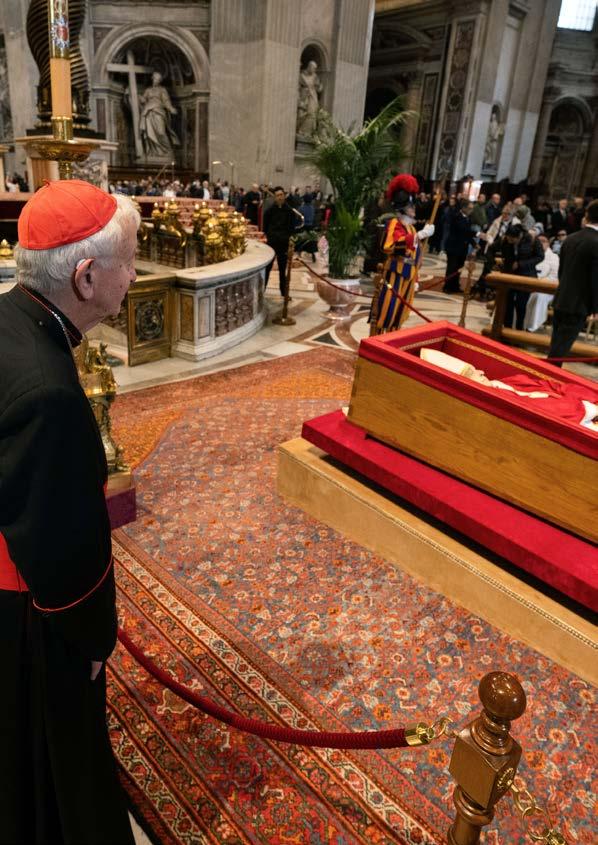

Although we have no birth date for Fr John Lloyd, a Jesuit, it is believed that he was born in Brecon. He took his missionary oath at Valladolid on 16 October 1649 and joined the Society of Jesus on 7 September 1665. He was then ordained at Liege and sent on the Welsh Mission in 1675.
Shortly before Fr Philip Evans’ arrest (see Part 2), Fr John was also arrested at Sker House, home of Mr Turbeville at Penllyn, Glamorgan on 20 November 1678, and thrown into Cardiff Gaol. The pair were brought to the bar on Monday 5 May 1679, charged with the crimes of being priests and entering the Principality to celebrate the Mass. Being found guilty, they were sentenced to be hanged, drawn,
and quartered at Gallows Field, Pwllhalog, Cardiff. Fr John made only a brief speech as he said, ‘I was never a good speaker in my life.’
Two plaques mark the site of their execution at the junction of Crwys Road and Richmond Road, Roath, Cardiff which is still known as ‘Death Junction’. St Philip and St John share a feast on 22 July.
St David Lewis SJ, aka Charles Baker 1616-79
St David Lewis, a Jesuit, was born in Abergavenny in 1616. Raised as a Protestant, he was the youngest of nine children of the Revd Morgan Lewis, Protestant headmaster of King Henry VIII Grammar School, and Margaret Pritchard, a Catholic.
He attended the Royal Grammar School at Abergavenny, and was then sent to London at the age of 16 to study law at the Middle Temple. Three years later, he went to France as a private tutor to the son of Count Savage and was likely reconciled with the Catholic Church in Paris, before returning to Wales. He then travelled to Rome in 1638, to study for the priesthood at the Venerable English College, where he was ordained a secular priest in July 1642. He joined the Society of Jesus in 1645, returning to Wales as a missionary in 1648. Here he was assigned to a remote farmhouse in Abergavenny, where the Jesuits maintained their western centre. For approximately 50 years this centre was the hiding place of Jesuits and other hunted priests. Fr David worked for the next 31 years in the Welsh-English borderlands where many recusants lived. Known as ‘Tad y Tlodion ’ , ‘Father of the Poor’, he was zealous in his spiritual and material care.
In 1678, the infamous Titus Oates claimed to have discovered an international plot to kill King Charles II. Royal officials pounced on the Jesuit College and all barely escaped with their lives. Fr Lewis went into hiding, but was arrested on 17 November 1678 as he was about to celebrate Mass. He was taken to Monmouth Gaol where he remained for two months and then tried at the March Assizes. Although condemned to death, he was next taken to London to answer charges by the Privy Council on the Titus Oates Plot. He gave no information and refused an offer of forgiveness if he would conform to the Anglican Church.
Fr Lewis was returned to Usk and, on 27 August 1679, he was tied to a hurdle, with his head at ground level,
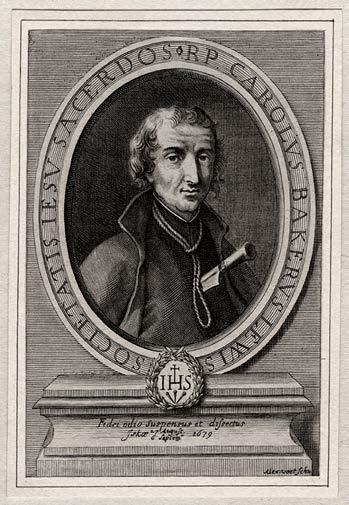
and dragged along the river path to a site believed to be within the grounds of what is now Porth-y-Carne House, opposite the current Catholic Church of St Francis Xavier and St David Lewis. Such was the love and respect of the people for Fr Lewis that the executioner fled. No one could be found to carry out the execution, until a blacksmith was finally bribed to carry out the death sentence. He was allowed to give a farewell speech from the scaffold in which he said
that while his flesh and blood urged him to demand revenge, the Gospel commanded forgiveness of enemies and he would obey the Gospel. He urged all his listeners to fear God, honour the King, stand firm in the faith, and avoid mortal sin.
St David Lewis was the last Catholic martyr in Wales. He is also remembered on 1 December as one of the Martyrs of the English College in Rome. A plaque in Usk marks the place of his execution.
In 1965, as part of the reorganisation of local government in London, the former Metropolitan Boroughs of Westminster, Paddington, and St Marylebone were amalgamated to form the City of Westminster we are familiar with today. As such, the Mayor of Westminster was elevated to Lord Mayor following the issue of letters patent. In total, 32 London Boroughs were created as a result of various amalgamations. Some took ‘neutral’ names when the boroughs concerned could not agree on a suitable designation. For example, the former Boroughs of Wembley and Willesden became the London Borough of Brent.
On Ascension Day, 26 May 1960, Cllr Robert Everest was elected Mayor of the City of Westminster, having attended Mass in the Lady Chapel that morning, celebrated by the Cathedral SubAdministrator Canon Francis Bartlett. In celebration, the Cathedral Chronicle notes that the Union Flag was flown from one of the Cathedral flagpoles that afternoon. In those days, flags on most public buildings were only flown on special occasions.
Following the election, the Mayor and Mayoress attended High Mass in Civic State on Trinity Sunday, along with Aldermen (an office since abolished) and City Councillors. They were received at the West Door by the Administrator, Mgr (later Bishop) Gordon Wheeler and escorted to their seats in the front of the nave.
Solemn High Mass was then sung by Dom Rupert Everest OSB of Ampleforth, son of the Mayor and Mayoress, with Cardinal William Godfrey (Archbishop of Westminster 1956-63) presiding at the throne in his summer cappa magna, with its watered silk train. For the record, the Cathedral Choir sang Mozart’s Missa Brevis in Bb (K275).
Cllr Everest was the third Catholic Mayor of Westminster since 1900, when the City was established as a local
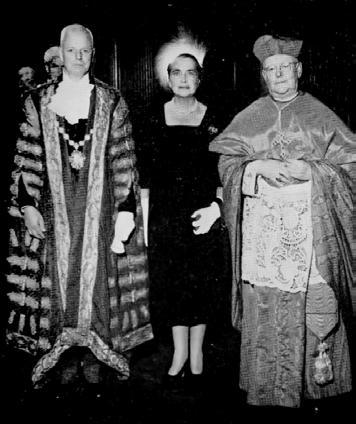
authority under its first Catholic Mayor, the 15th Duke of Norfolk. Subsequently, there have been a number of Catholic Lord Mayors including Cllrs John Wells (1971), Angela Hooper (1994) and the
current Lord Mayor, Robert Rigby, whose term of office ends this month.
Source: Westminster Cathedral Chronicle, July 1960
Paul Tobin, one of the Cathedral MCs and a faithful contributor to Oremus, is preparing to undertake a section of the Via Francigena Camino from Montefascione to Rome, as part of a small group. Paul is using this walk to raise funds to support the Cardinal Hume Centre and its work with young people, children and families in need, tackling the pressing issues of homelessness, poor housing and poverty.
If you would like to support Paul’s efforts and the work the Cardinal Hume Centre undertakes in Westminster, please visit his Just Giving page.


Mr Robert O’Brien, Deputy Head (Academic) & Head of Boarding, Westminster Cathedral Choir School
On Monday, 24 March the Cathedral Choir flew 3,665 miles from London Heathrow to Washington Dulles to embark on their first tour of the USA since 2011. Led by the Master of Music, Simon Johnson, the Organ Scholar, ten Lay Clerks and 19 choristers (chaperoned by three boarding staff), the Choir performed masterpieces from their repertoire to thousands in seven cities, in just over two weeks.

Our first port of call on the US tour was the nation’s capital. Here, the Choir had the privilege to sing at the National Shrine of the Immaculate Conception, the focal point of American Catholicism. Not dissimilar to Westminster Cathedral, the National Shrine is Romanesque-Byzantine in style, having recently completed their mosaic interior. Indeed, the Trinity Dome, completed in 2017, is the largest mosaic in the world.
Although not every seat was taken, the basilica can seat over 10,000 people and is the largest church in America, with 80 altars dedicated to the Blessed Virgin Mary under her various designations. As it was the Feast of the Annunciation, we attended Mass in the beautiful crypt, where we were graciously welcomed by the Shrine Rector, Mgr Rossi.
That evening, the Choir’s unmistakable sound reached American ears for the first time on this tour, reverberating around the domes of the enormous basilica. It was hard to believe that little more than 24 hours earlier we had been on Ambrosden Avenue receiving a blessing from Fr Brian, our Chaplain. The long-awaited tour had truly begun!
The following morning, we had time for sight-seeing. Starting in the shadow of the Washington Memorial, the landmark needle visible for miles around, we strolled in the brisk wind alongside the Reflecting Pool (think Donald Sutherland and Kevin Costner in JFK) towards the iconic Lincoln Memorial. On the spot of Martin Luther King’s ‘Dream’, we stood at the feet of the ruminating President Lincoln and read his words from Gettysburg:
‘Four score and seven years ago our fathers brought forth on this continent, a new nation, conceived in Liberty, and dedicated to the proposition that all men are created equal.’
From DC, we travelled by coach to Ronald Reagan Airport, for a flight of just over 1,000 miles west to Omaha, Nebraska, to perform at St Cecilia’s Cathedral. The cathedral, in keeping with its patroness, has an outstanding musical reputation, a rich, resonant acoustic, and a well-established concert series. Mr Daniel Greenway (Organ Scholar) enjoyed the rare Pasi dual-temperament pipe organ and no fewer than seven seconds of reverberation.

While in Omaha, the choristers had the opportunity to visit the famous Henry Doorly Zoo and Aquarium. We would like to thank the Zoo managers who, when they heard that we had travelled further than many of the animals, waived our entrance fee. We saw giraffes, meerkats, elephants, cheetahs, gorillas, monkeys, orangutans, hogs, bat-eared foxes, cobras, owls, and, in the mesmerising Aquarium, shoals of exotic fish and sea-creatures. Sadly, we only had three hours to spare, not the three days we would have needed to see everything. Wishing we could stay longer, we bade a grateful farewell to the generous families who had accommodated us and given us a taste of Omaha.

Six hours along straight roads through northwest Iowa, bordered by endless cornfields, brought us to Minnesota, famous for its lakes and waterfalls. St John’s Abbey has its own university for some 6,000 students. Although classes are mixed, the young men live on the monastery campus, and the young women reside in nearby St Joseph’s, with the sisters. The monks also have their own lake, Lake Sagatagan, but the first thing you see is the concrete bell-banner over the trees. We pulled into the abbey and were met by a monk of the community and the wonderful host families.
The community numbered some 450 monks in the 1950s, and so the original abbey church (now the great hall) was replaced by a larger, modernist design in concrete, based around a circular sanctuary. Collegeville, well known for its Liturgical Press, was at the vanguard of the liturgical reforms and the new church, built 1959-61, was deemed pioneering.
The Collegeville concert differed from our other performances by accommodating vernacular congregational hymns, and so Rheinberger, Howells, and Macmillan rubbed shoulders with ‘My Song is Love Unknown’ and ‘Love Divine, All Love’s Excelling’.
At every turn we experienced Benedictine hospitality from Abbot Mullin and the Collegeville community. One of the lay clerks was a chorister when the Choir performed here in 2011. On our final morning, Sunday, the snow arrived (this is Fargo -land). After a Mass celebrated for us by Fr Anthony Ruff OSB, the ‘Pray Tell’ blogger, the boys were permitted a late March snowball fight but not, for fear of catching colds, to roll in the snow.

As we reached the tour’s midpoint, some of our exuberance was beginning to wain! Having flown from Minneapolis-St Paul to St. Louis, we settled into our hotel next to the St. Louis Gateway Arch and the Mississippi River. The Gateway is the world’s tallest arch, and occupies the site of the founding of St. Louis on 14 February 1764, by three French fur traders. It was from here, at the confluence of the Mississippi and Missouri rivers, that the highways of railroad and river stretched out west.
So we piled into cramped five-person capsules, and went clicking and jolting up the steep track inside the arch. From the top we surveyed the vista and contemplated how the west was won, followed by a ‘cruise’ of the Ole’ Miss. Sadly the industrial scenery didn’t evoke Huckleberry Finn , but we enjoyed our lunch and exploring the decks.
Upon returning to the hotel, we realised that one of the cassock cases was missing. Thankfully a resourceful house master, Mr Deery, tracked it down at the airport, to the relief of the Master of Music. Thank you, St Anthony!
The Cathedral Basilica of St. Louis is just as spectacularly domed and mosaiced as the National Shrine. Much like Omaha, it also boasts a strong concert programme and liturgical tradition, thanks to its dedicated leadership and staff, and the concert was well-attended. The basilica is the resting place of Cardinal Joseph Ritter who desegregated Catholic schools in the Archdiocese in 1947, while Dr King was still a teenager, and long before the Supreme Court ruled on the matter in 1954.

The 6am coach departure was a tall order but we made it, flying two hours from St. Louis to Pittsburgh, the ‘City of Bridges’. Here, 446 bridges (more than Venice) cross three converging rivers; the Allegheny, the Monongahela, and the Ohio, providing extensive, elegant waterfronts for walking and cycling.
Andy Warhol, an Eastern-rite Catholic, was born here in 1928 to Slovakian parents. But the highlight was the boys’ visit to the Museum of Illusions, followed by lunch at ‘Burgatory’. However, little temporal punishment was experienced.
In Pittsburgh, the Choir had been invited to sing Mass which, after so many concerts, felt like a novelty. The pastor, Fr Brian Welding – evidently thrilled that we were singing at his parish – reminisced that years ago he had been profoundly affected at hearing the Allegri Miserere at Westminster Cathedral. We received an incredibly warm welcome in Pittsburgh and were hugely impressed by the organisation evident in this dynamic parish. Thank everyone on the staff who made our stay so enjoyable.
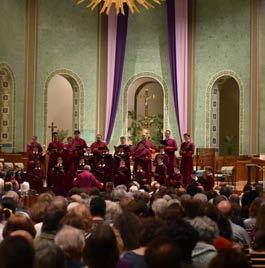
Perhaps the least well-known stop on the tour, Altoona, on the eastern slopes of the Allegheny Mountains, was once a major hub for the Pennsylvania Railroad. Seat of the Bishop of Altoona-Johnstown, the Cathedral of the Blessed Sacrament had placed our concert at the centrepiece of their celebrations for the Jubilee Year of Hope. Once the boys heard this, and saw the army of volunteers who were involved in making this event a success, they were determined to make this an even more spectacular performance. As a special Jubilee event, the cathedral had made entry free, enabling many young people and families to attend.
We were warmly welcomed by Mgr Carson, the Cathedral Administrator, and fed with a sumptuous lunch of pulled pork, baked corn and coleslaw, amongst other American dishes, served by wonderful cathedral helpers.
After the concert, Bishop Bartchak came to meet the Choir and then, as it was raining, a yellow school bus materialised to take us back to our hotel. Few of us had heard of Altoona before this tour, but we will now always remember their great hospitality.
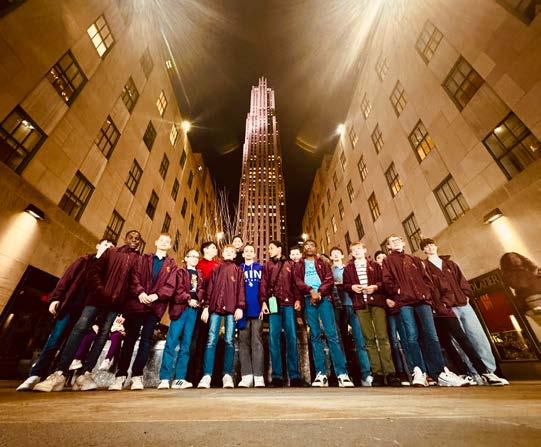
New York, New York!
Finally, we had just over three days in the Big Apple! We wasted no time after check in, heading straight to the ‘Top of the Rock’ viewing decks at the Rockefeller Center. Needless to say, we didn’t pay the extra $25 to re-enact the famous photograph of the workers eating their lunch on the steel beam suspended over Manhattan, but it did look fun. At 70 floors up, the views are astonishing. Central Park and beyond can be seen to the north, the Empire State Building to the south and, far beyond it, the Statue of Liberty. There was as much to look up at as there was to see below. Then it was time for dinner at Bill’s Burgers on 51st St before returning to our hotel, just off Times Square.
On Saturday, we visited the American Museum of Natural History, of Night at the Museum fame, on the Upper West Side and, in the evening, the boys were treated to a baseball game at the Mets.
On Sunday, after attending Mass, we headed to the Upper East Side and the Jesuit Church of St Ignatius; an extremely fine church not dissimilar in stature to Farm Street. We were delighted to be joined by a number of chorister families for this
final concert of the tour – another brilliant performance, and another standing ovation from an audience who knew the rare excellence of this great and famous Choir.
On Monday morning, having packed our cases, we had the opportunity to see the New York Stock Exchange on Wall Street, and Trinity Church. Founded by King William III in 1697, the church owns Wall Street and is, therefore, the wealthiest church in the world. We then walked the short distance to the 9/11 Memorial, a place of rare serenity in New York, where we read the names inscribed and watched the tear-like fountains pour into the dark abyss of the Twin Towers’ former foundations. There we prayed for our American cousins and thanked God for a safe and happy tour.
Particular thanks are due to our Tour Agent, Mr John McElliott, who not only planned the entire tour, but helped to chaperone the chaperones. As such, the boys were able to experience so many highlights in between their performances. We are also grateful to Cardinal Nichols and to the Cathedral Chaplains for their support, and for permitting the Choir’s absence from choral liturgies.

In April, His Holiness Pope Francis RIP appointed Bishop John Sherrington as Archbishop of Liverpool. Ordained as a priest for the Diocese of Nottingham on 13 June 1987, Bishop Sherrington has been an Auxiliary Bishop of Westminster and Titular Bishop of Hilta since 14 September 2011. Hilta, now buried by sand in Tunisia and part of the Metropolitan See of Carthage, serves as a reminder of prayer for persecuted Christians.
Archbishop-elect Sherrington will become the tenth Archbishop of Liverpool in succession to Archbishop Malcolm McMahon OP, who has been Archbishop of Liverpool since 2014. His farewell Mass will take place on Thursday 15 May at 5.30pm in Westminster Cathedral, and his installation will take place in the Metropolitan Cathedral of Christ the King, Liverpool on Tuesday 27 May at 12 noon.
‘I thank Pope Francis for his trust in me on my appointment as Archbishop of Liverpool which I accept with humility and joy. We pray for our Holy Father at this time of sickness as he recuperates and prepares for Holy Week and Easter.
I have enjoyed serving God’s holy people, especially clergy and parishes in Hertfordshire and North London, in the Diocese of Westminster. The celebration of confirmation has always been a special moment to reflect on the power of the Holy Spirit in each young person’s life and the call to serve God and neighbour.
I look forward to serving as shepherd of the historic and faithfilled Church in the Archdiocese of Liverpool which is rich in
its heritage of the English martyrs, Irish immigration, and now looks to the future.
Archbishop Malcolm McMahon OP has served Liverpool Archdiocese with love and generosity and I am honoured to succeed him. I am pleased he is staying close ‘in our Liverpool home’ and close in prayer is Archbishop Patrick Kelly.
I look forward to working with Bishop Tom Neylon and Bishop Emeritus Tom Williams. I have a lot to learn about the Archdiocese: its geography, its people, and its history. I look forward to building on the foundations already laid in the synodal pastoral plan ‘Together on the Road’ to serve the Church and bring the hope and joy of Jesus Christ to all people. Coming from Leicester, with its football team ‘The Foxes’, I can only look with envy to the top of the Premier League.
In this Jubilee Year, we are a people living the hope of Christ who has loved us, saved us and walks with us. We share this hope with other Christians and people of all faiths and good will. I welcome meeting and building friendships with leaders, both Christian and of other faiths, which has always been a strong dimension of the Church here. May we receive the fire of the Holy Spirit into our hearts to bring Christ to others.
I ask your prayers and the intercession of our patron saints, Our Lady Immaculate, St Joseph and St Kentigern, and the martyr saints of the Diocese.’
On 7 May 1945, Field Marshal Alfred Jodl signed the simultaneous surrender of the German armed forces on all fronts. The following day, 8 May, was celebrated by the Western Allies as VE Day. In Britain, Churchill’s call for a brief period of rejoicing was followed by the decking out of streets in red, white, and blue bunting. The press and newsreels of the time also recorded widespread street parties, bonfires, fireworks, and uninhibited public celebrations. A wonderful excuse for a party!
At Westminster Cathedral, the reaction was more restrained. The building itself had been spared a direct hit, but nearby bomb blasts had forced the stone slabs covering the domes apart, allowing water through and staining the ceiling white. The baldacchino, sanctuary columns and grand organ loft were protected with scaffolding, while the reliquary of St John Southworth was surrounded by sandbags. The new floor mosaics in St Joseph’s and St Andrew’s Chapels were covered with protective planks, while the Crypt and adjoining store room had been used as an air raid shelter.


The first signs that the war was over appeared when workmen came to dismantle the scaffolding in the sanctuary. By VE Day, the sanctuary was cleared and High Mass was celebrated at 10.30am. Just before 4pm, Archbishop Bernard Griffin gave an unadvertised Pontifical Benediction. By this time, Catholic Members of Parliament had arrived and the Cathedral was crowded. Anglican MPs, led by the Speaker of the House, had done likewise in St Margaret’s, Westminster. At 8pm, the Cathedral was again crowded for the Solemn Te Deum and Pontifical Benediction. The National Anthem was also sung at the end of both Benedictions and the High Mass.

The gutted remains of St Andrew’s (Anglican) Church, Ashley Place, destroyed in late 1940.
The following Sunday, 13 May, a Thanksgiving Mass was celebrated, attended by the Duke of Norfolk, senior officers from the Forces, including Dame Vera Laughton whose St Nicholas memorial is on the north aisle. The Archbishop’s sermon was broadcast live by the BBC Home Service and recorded for a shorter US broadcast.
Westminster Cathedral Chronicle, May 1925
Varia
The Cathedral Tower was opened again on Holy Saturday. All possible danger points have been safeguarded by iron grilles, so that there is now no fear of any recurrence of the terrible tragedy that occurred just over a year ago. On the first day of the re-opening 140 people went up the tower, and between that day (11 April) and Good Shepherd Sunday (26 April) 1,098 mounted its hundreds of steps to experience what is undoubtedly the finest possible view now obtainable in London. A visit is to be recommended especially in the month of May, when we are often favoured with very clear atmosphere.
vocation was sown through service in this Archconfraternity. Living conditions today are probably much more difficult, and the obstacles against boys serving daily Mass regularly, are greater than they were in 1905. Yet no priest today need lament that he cannot get servers; he has only to start a Guild of St Stephen and soon he finds an enthusiasm which surmounts all difficulties.
His Eminence had already formed a special guild of servers for the Cathedral itself, under the patronage of St Gregory, a year earlier. When its construction was later approved by St Pius X, the Sovereign Pontiff directed that it should be affiliated to the Archconfraternity of St Stephen so that its members could participate in the indulgences. In 1934, the power to affiliate servers’ guilds was extended by the Sovereign Pontiff to all British Dominions, and there are now several foundations in Australia, South and West Africa, Ceylon and Malta.
Westminster Cathedral Chronicle, May 1955 A CATHEDRAL FESTIVAL
The Golden Jubilee of the Archconfraternity of St Stephen for Sanctuary Servers
The Very Rev Mgr Edward Sutton
Our Cathedral is primarily the home of the sacred liturgy, but it is also a place of great national celebrations at which we may feel the spiritual pulse, as it were, of the Catholics of this country. So, on Whit-Monday, when the liturgy of the Monday of Pentecost has been fully celebrated, His Eminence Cardinal Griffin will take his place at his throne to preside at a solemn High Mass of Thanksgiving for the Golden Jubilee of the Archconfraternity of St Stephen.
On this occasion, nearly the whole of the nave of our great Metropolitan Cathedral will become part of the sanctuary. For in the course of 50 years, the Guild, first erected in the Cathedral by Cardinal Bourne in 1905, and raised to the rank of an archconfraternity by St Pius X the following year, has spread to every diocese in England and Wales, and even to the British Dominions overseas. From all over the country we hear of groups of servers who wish to take part in this act of thanksgiving, wearing their cassock, cotta, and the medal of St Stephen; that precious symbol of devotion to their sacred duties.
The vision of a humble priest, Fr Hamilton Macdonald, chaplain to the Sacred Heart Convent, Hammersmith, has become a great reality. Today in many parishes in England and Wales, in religious orders, and in the Mission field, there are several hundred priests in whom the seed of their sacerdotal
Many members who enrolled in the early years later gave their lives for their country in the First World War. A few who returned, together with those who had been too young for service in the Forces, formed the nucleus for its revival about two years after peace had been declared. At this time some amendments to the constitution and a revised rite of enrolment, introducing promises by the candidates and making it generally more impressive, received the approbation of the Cardinal Archbishop and the Holy Father. During the period between the two wars, the Central Advisory Council was greatly developed by inviting all parishes within the London area to send a representative to the monthly meetings.
In Jubilee Year, about 90 Guild members with their priest directors, made a pilgrimage to Rome. From the Convent of Santa Marta in the Vatican City where they stayed, they went, robed in cassock and cotta and wearing their Guild medals, in procession to the four great basilicas and, in each, sang the Jubilee devotions. Naturally too, they made a pilgrimage to the tomb of St Stephen, and also went in procession through the catacombs of St Agnes, singing the litanies of the saints. At a great public reception of pilgrims by the Holy Father in St Peter’s, they were accorded a special front place. Another pilgrimage to the tomb of St Stephen in Rome, and to the Holy Father, is planned for this year of our Golden Jubilee, and already over 400 members have signified their desire to take part.
In grateful memory of their founder, Fr Hamilton Macdonald, the Council is providing a memorial plaque, which will be blessed by His Lordship Bishop Craven and installed in the chapel of the Sacred Heart Convent, Hammersmith on 12 May.

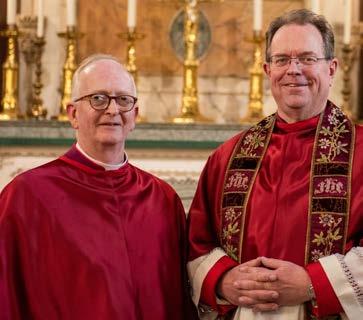
On Lætare Sunday, new meaning was given to the introit ‘Rejoice, Jerusalem, and all who love her…’, as we were joined at the evening Mass by Bishop William Shomali, Auxiliary of the Latin Patriarchate in Jerusalem, and representatives of Aid to the Church in Need.
On Tuesday 1 April, Fr Chris Vipers (left) was installed as a Canon of the Metropolitan Chapter by Canon Provost Shaun Lennard (right). Pictured here, Canon Vipers wears his new Lateran choir dress, including a purple cassock, rochet and cappa parva (short cape).


On Easter Monday morning, Sub-Dean Fr Brian O’Mahony lowered the flag of the Holy See to half-mast. Later that day, the Union Flag was also lowered, following the example of Government buildings and Royal palaces (where the King was not in residence).
In the initial few days of mourning, a huge number of people have come to sign books of condolence for Pope Francis, including the Papal Nuncio, Diplomats, the Lord Mayor and Lady Mayoress, Lord Khan, Councillor Adam Hug - Leader of Westminster City Council, and Jim McMahon MP.
Congratulations to Councillor Robert Rigby, Lord Mayor of Westminster, who was invested as a Knight of St Gregory. Established in 1831, the Pontifical Equestrian Order of St Gregory the Great was established as an honour for lay Catholics who serve the Church in public life. In addition to his support of the Cardinal Hume Centre and other Catholic charities, Councillor Rigby is a lifelong Catenian and the former chair of the Catholic Union.



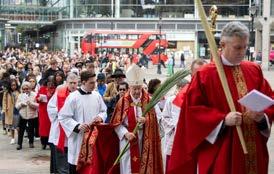

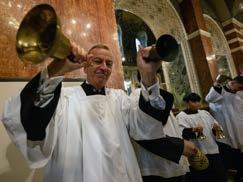


Allen, Coordinator (2022-25)
‘Lord, I have loved the habitation of thy house, and the place where thine honour dwelleth.’
So saith the psalmist (Psalm 26:8 KJV), and so too have I felt during the two and a half years I have been privileged to work at Westminster.
I still vividly remember the first time I visited Westminster Cathedral, aged eight. On Saturday 14 September 2008, I travelled with my father from my native, rural Lancashire to see the presbyteral ordination of my godfather, Fr James Neal (now Parish Priest of Fulham). The sheer scale of the place, the sound of the music, and greeting Fr James in the Lady Chapel afterwards, are all things I remember as if they were yesterday. Never did I imagine, especially as an Anglican, that my first job would be here as Friends’ Coordinator.
The Friends of Westminster Cathedral play a fundamental part in maintaining and furthering the sacred fabric and function of this place, and I am pleased to have played a small part in the charity’s continued success in this regard. In a particular way, I am proud to have contributed to the post-Covid recovery of the Friends which continues apace.
Since 2022, Big Give fundraising campaigns have gone from annual to triannual fixtures, firmly rooted in the fundraising life of the charity and of the Cathedral. Always reaching, and often exceeding our targets, well over £400,000 cumulatively has been invested in new mosaics, new lighting, and restored flooring. For my part, I have been continually amazed and humbled by the response of donors to our campaigns as the seasons have gone by.
Quiz nights, walking tours, and church visits have all attracted varied and dedicated crowds, thanks in no small part to the volunteers and supporters who make these events possible – you know who you are. For a number of months we ran a series of private evening tours, welcoming several
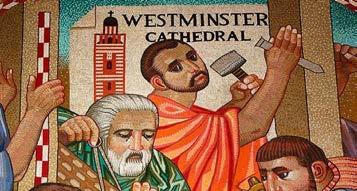
hundred people to the Cathedral over successive nights from a variety of parishes and organisations, showcasing the beauty of the Cathedral and our mission as part of it. Then there were higher-profile events such as a ‘Coronation Reflections’ panel discussion in 2023 and a Beer & Wine Tasting Evening in collaboration with Monastic Order in 2024.
With much productivity and a chain of fundraising achievements, the indications are that the Friends will continue to progress and go from fundraising strength to strength.
However, my involvement in this journey now comes to an end, as I leave the Friends in early May. In February 2025 I began a PhD at St Mary’s University, Twickenham, researching liturgy and sacrifice in the thought of Joseph Ratzinger/Pope Benedict XVI. With other professional work in the Church of England taking up the rest of my time, now seems like the natural time to bid farewell to Clergy House so that I can pay due attention to my academic research.
I will miss the Cathedral dearly, but look forward to see it continue to flourish in the future. Pray for me as I pray for you. For the beauty of the architecture and the
dignity of the music that I marvelled at as a child, I hope that like St John Paul II and Benedict XVI, the next Pope will pay a visit one day. Then again, with so many Cardinals gracing our Cathedral year by year, perhaps he already has.
Full information and booking details are available on Eventbrite (Google: Eventbrite Westminster Cathedral), or email friends@rcdow.org.uk.
Wednesday 28 May, 6.30pm – Quiz Night with Fr Brian O’Mahony, Sub Dean.
Thursday 12 June, 6.30pm – Talk on The Venerable Ignatius Spencer by Fr Gerard Skinner.
Tuesday 30 September, 6.30pm –Quiz Night with Fr Hugh Mackenzie.
Thursday 20 November, 6.30pm –Quiz Night with Fr Patrick van der Vorst, Precentor.
Details of the Friends’ Annual General Meeting will be communicated to members in due course.
Queen Catherine of Aragon to Blessed John Forest OFM
‘My venerated Father, you who have been accustomed to advise others in doubtful cases know best what advice to give yourself. You know without doubt, to undergo death and refuse nothing in such a case. But, alas, you leave me, your daughter, born to you in the Wounds of Christ, for a time at least, in the greatest sorrow. For I am losing in you the man who has taught me the most in divine things. Yet I trust in the Lord that I shall see you not very long hence, when I shall be taken to the calm life of the blessed. Farewell, my honoured Father, commend me always to God, now and from your place in Heaven. Your most sorrowful daughter, Catherine.’
Bl John Forest at St Etheldreda’s, Ely Place by John Salmon

The Holy Father’s Prayer Intentions
For working conditions.
Let us pray that through work, each person might find fulfilment, families might be sustained in dignity, and that society might be humanised.
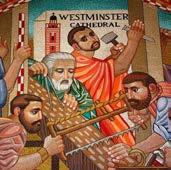
Thursday 1 May 2025
Easter Feria
(St Joseph the Worker) Day of prayer for human work.
2.30pm Memorial Service, the Marquess of Lothian RIP (Bishop Curry)
Friday 2 May 2025 Friday abstinence St Athanasius, Bishop & Doctor
Saturday 3 May 2025
Ss PHILIP and JAMES, Apostles
2pm Parish First Holy Communion Mass
4pm Low Mass (Blessed Sacrament Chapel)
6pm Vigil Mass with Adult Confirmations (Bishop Campbell)
Sunday 4 May Ps Week 3
3rd SUNDAY OF EASTER
12 noon Solemn Mass (Full Choir)
F. Martin – Messe Bassano – Dic nobis Maria
Organ: Tournemire – Choral-Improvisation sur le “Victimæ Paschali
The Cathedral is open from 7.30am and closes in time for 7pm.
Monday to Friday: Morning Prayer 7.35am, Mass 8am, Mass (Latin, unless there is a Funeral) 10.30am, Confessions 11.30-12.30pm, Mass 12.30pm *, Exposition of the Blessed Sacrament 1.15-4.30pm, Benediction 4.30pm, Confessions 4.30-5.30pm, Sung Vespers 5pm (Latin, Choir, except Tuesday, English, Cantor), Solemn Mass 5.30pm (Choir, Tuesday: Boys’ voices, Wednesday: Men’s voices)
Saturday: Mass 8am, Morning Prayer 10am, Mass 10.30am (Latin, Choir,) Confessions 11.30-12.30pm, Mass 12.30pm *, Confessions 5-6pm, Sung Vespers 5.30pm (English, Cantor), Sung Mass 6pm.
Sunday: Mass 8am, Sung Morning Prayer 9.30am, Sung Mass 10am, Confessions 10.30-12.30pm; Solemn Mass (Choir) 12noon *, Solemn Vespers (Choir) and Benediction 4pm, Confessions 5-6.45pm, Sung Mass 5.30pm, Mass 7pm.
For full opening and closure times of the Cathedral and for confession and service times please consult the Cathedral diary on the website.
* Live streamed via the Cathedral website
4pm Solemn Vespers and Benediction Vivanco – Magnificat octavi toni Taverner – Dum transisset Sabbatum Organ: Franck – Choral No 1 in E major 4.30pm Mass for the Deaf Community (Cathedral Hall)
Monday 5 May (Bank Holiday)
Easter Feria
2.30pm Mass for Migrants (Archbishop Stack)
Tuesday 6 May
Easter Feria 5.30pm Chapter Mass
Wednesday 7 May
Easter Feria 1.15pm Lunchtime Concert
Thursday 8 May
The 80th anniversary of Victory in Europe (VE Day)
Easter Feria
Friday 9 May Friday abstinence
Easter Feria
Saturday 10 May
Easter Feria (St John of Avila, Priest & Doctor)
2.30pm Service of Healing and Hope (Cardinal Nichols)
6pm Mass for New Catholics (Cardinal Nichols)
Sunday 11 May Ps Week 4
4th SUNDAY OF EASTER
World Day of Prayer for Vocations
12 noon Solemn Mass (Full Choir)
Palestrina – Missa brevis
MacMillan – He has not created me for naught
Organ: Widor – Final (Symphonie romane)
4pm Solemn Vespers and Benediction
Palestrina – Magnificat quarti toni
L’Héritier – Surrexit pastor bonus
Organ: Widor – Moderato (Symphonie romane)
Monday 12 May
Easter Feria
(Ss Nereus and Achilleus, Martyrs; St Pancras, Martyr)
Tuesday 13 May
Our Lady of Fatima
Wednesday 14 May
St MATTHIAS, Apostle 1.15pm Lunchtime Concert
Thursday 15 May
Easter Feria
5.30pm Farewell Mass for Archbishop-elect
John Sherrington (Cardinal Nichols)
Friday 16 May Friday abstinence Easter Feria
Saturday 17 May
Easter Feria
2.30pm Matrimony Mass (Cardinal Nichols)
Sunday 18 May Ps Week 1
5th SUNDAY OF EASTER
12 noon
Solemn Mass (Full Choir)
Bingham – Mass for Westminster Cathedral
Guerrero – Hoc est præceptum meum
Guerrero – Vos amici mei estis
Organ: Schmidt – Prelude & Fugue in D “Hallelujah!”
1pm Youth Confirmandi Cake Sale
4pm Solemn Vespers and Benediction
Victoria – Magnificat septimi toni
Howells – Regina cæli
Organ: Messiaen – Combat de la mort et de la vie (Les Corps Glorieux)
Monday 19 May
Easter Feria
Tuesday 20 May
Easter Feria
(St Bernardine of Siena, Priest)
5.30pm
The Society of St Augustine of Canterbury attend Mass
Wednesday 21 May
Easter Feria
(St Christopher Magallenes, Priest, and Companions, Martyrs)
1.15pm Lunchtime Concert
Thursday 22 May
Easter Feria
(St Rita of Cascia, Religious)
5.30pm Solemn Mass for the 165th anniversary of Providence Row (Bishop Hudson)
Friday 23 May Friday abstinence
Easter Feria
5pm Joint Vespers with Westminster Abbey
Saturday 24 May
Easter Feria
Sunday 25 May
6th SUNDAY OF EASTER
Ps Week 2
12 noon Solemn Mass (Men’s voices)
Lassus – Missa Congratulamini mihi
Lassus – In illo tempore dixit Iesus
Guerrero – O sacrum convivium
Organ: Tournemire – Improvisation sur le Te Deum
4pm Solemn Vespers and Benediction
Suriano – Magnificat septimi toni
Palestrina – Regina cæli
Organ: Reger – Te Deum
Monday 26 May (Bank Holiday)
St Philip Neri, Priest
Tuesday 27 May
St AUGUSTINE OF CANTERBURY, Bishop
Wednesday 28 May
Easter Feria
1.15pm Lunchtime Concert
5.30pm Vigil Mass (fulfils obligation)
Thursday 29 May
THE ASCENSION OF THE LORD
(Holy Day of Obligation)
5pm Solemn Second Vespers
5.30pm Solemn Mass (Men’s voices)
Palestrina – Missa Viri Galilæi
Palestrina – Viri Galilæi
Palestrina – Ascendit Deus
Organ: Messiaen – Transports de joie (L’Ascension)
Friday 30 May Friday abstinence Easter Feria
Saturday 31 May
THE VISITATION OF THE BLESSED VIRGIN MARY
2.30pm Deanery Youth Confirmations

Key to the Diary: Saints’ days and holy days written in BOLD CAPITAL LETTERS denote Sundays and Solemnities, CAPITAL LETTERS denote Feasts, and those not in capitals denote Memorials, whether optional or otherwise. Memorials in brackets are not celebrated liturgically.
Catholic Evidence Guild
Clergy House Room 2, Tuesdays 7pm
Catholic Grandparents’ Association Hinsley Room,
Second Sundays 12-3.30pm
Charismatic Prayer Group
Cathedral Hall, Fridays 6.30-9pm
Divine Mercy Prayer Group
St Patrick’s Chapel, Sundays 1.30-2.30pm
Filipino Club
Cathedral Hall, Second Sunday 1-5pm
Guild of the Blessed Sacrament
Blessed Sacrament Chapel, Mondays 6.15pm
Guild of St Anthony Lady Chapel, Tuesdays 6.15pm
Interfaith Group Hinsley Room, Third Wednesdays 1.30 -3pm
Legion of Mary Hinsley Room, Monday 1.30-3.30pm
Nigerian Catholic Association
Hinsley Room, Fourth Sundays 1.30-2.30pm
Oblates of Westminster Cathedral Hinsley Room, Fourth Sundays 2.30-4pm
Padre Pio Prayer Group
Sacred Heart Church, First Thursdays 1.30-3.30pm
Rosary Group
Lady Chapel, Saturdays 11.15-12.00noon
Walsingham Prayer Group
St George’s Chapel, First Tuesdays 2.30-4pm
Yoruba Association
Hinsley Room, Third Sundays 1.30-3pm ©
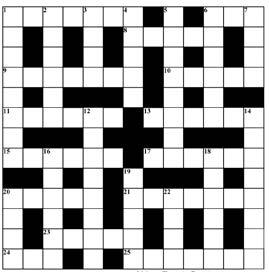
Clues Across
1 Depending upon old three-wheeler? (7)
6 Bread for male swan? (3)
8 Fish sounds like English Cardinal in Rome (5)
9 Means of entry (7)
10 Last of the Commandments (5)
11 Former Emperor with Column in the city of Rome (6)
13 Passage in the Mass from an Evangelist (6)
15 Place where one on run may shelter (6)
17 Place where one on run may end up if caught! (6)
20 The Holy Cup with miraculous healing powers (5)
21 Famous Square and Cathedral in Venice, named after Evangelist (2.5)
23 Drink and plant (5)
24 & 12 Down: Brother and brilliant artist, e.g. of The Annunciation (3,8)
25 Thomas, Abp of Canterbury, who fixed Henry VIII’s divorce from Catherine (7)
Clues Down
1 Record of births, deaths, and pupils’ attendance! (8)
2 & 16: Common language for speakers of different languages (6,6)
3 Thomas, composer of Rule Britannia (4)
4 Secret meeting (5)
5 Open country in England with famous prison (8)
6 Look on the bright side with raised jaw! (4,2)
7 Roman city of curative waters (4)
12 See 24 Across
14 Sir Edwin, painter of animals and sculptor of the Lions in Trafalgar Square (8)
16 See 2 Down
18 Stretch of running water (6)
19 Son Abraham in obedience was prepared to sacrifice (5)
20 Land promontory or 18 in meteorology (4)
22 ‘---- Lisa’, Leonardo’s world-famous painting (4)
Amanda Hill Companion of Oremus
In that crisis of our history, when with Rome King Henry broke, few had courage to resist him, most of those were humble folk. In the Charterhouse at Smithfield, strictly living lives austere, men of sanctity and wisdom met to face a common fear.
Priors of Carthusian houses gathered from across the land, chose to ponder on the options, forced at last to take a stand. When the monks in church assembled, Prior Houghton told the host, choose they must for King or Conscience, aided by the Holy Ghost.
In the stress of their dilemma, they intoned a votive Mass, for the guidance of the Spirit, hoping that their cup might pass. When the Sacrifice was over, they again heard Houghton’s voice; as apostasy was evil, death alone could be their choice.
Suddenly with noise like thunder, rushing wind tore through the nave guttering candles, half-extinguished, yet no soul but felt more brave. Now they knew their choice was taken, theirs remaining but to die, since a signal unmistaken showed God’s answer to their cry.
Other orders vanished sadly from the cloisters of our land, only the Carthusian martyrs were distinguished by their stand. First to die for Rome since Becket, not a monk but failed to swear, such a sacrifice to heaven, such a stimulus to prayer.
Grant us, Lord, thy Holy Spirit, let it us, like them inspire. Where we too must choose in conscience, let us follow that good prior, who with several brave companions, Thomas More was moved to say, went to Tyburn, like a bridegroom, cheerful on his wedding day. To submit a poem whether by yourself or another for consideration, please contact the Editor – details on page 3.
‘A pilgrimage on foot is a great aid for rediscovering the value of silence, effort and simplicity of life. In the coming year, pilgrims of hope will surely travel the ancient and more modern routes in order to experience the Jubilee to the full.’
(Spes non confundit 5)
To celebrate the Jubilee Year, the Diocese of Westminster has created a seven-mile pilgrim route in the steps of saints and martyrs, our ‘Beacons of Hope’, beginning at Tower Hill and ending at Westminster Cathedral.

To download a leader’s guide and a pilgrim passport, visit: rcdow.org.uk/jubilee-2025/westminster-way
By Cathedral Chaplain Fr Gordon Wheeler (later
Bishop of Leeds), who took shelter in the Crypt when the V-1 ‘doodle-bug’ flying bombs were destroying the city around him.
I slept on marble, guarded from the skies, A Cardinal-Archbishop on each hand; I saw the scarlet tassels pendant-wise
Which the broad brows of noble prelates spanned: Wiseman and Manning, who the helm once manned In England; and a living glory smiles
Over the times when Second Springs were planned, Which summered in these soaring marble piles, Intrepid in the Faith, a glory in these isles.

